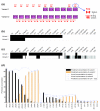SPACE: an algorithm to predict and quantify alternatively spliced isoforms using microarrays
- PMID: 18312629
- PMCID: PMC2374713
- DOI: 10.1186/gb-2008-9-2-r46
SPACE: an algorithm to predict and quantify alternatively spliced isoforms using microarrays
Abstract
Exon and exon+junction microarrays are promising tools for studying alternative splicing. Current analytical tools applied to these arrays lack two relevant features: the ability to predict unknown spliced forms and the ability to quantify the concentration of known and unknown isoforms. SPACE is an algorithm that has been developed to (1) estimate the number of different transcripts expressed under several conditions, (2) predict the precursor mRNA splicing structure and (3) quantify the transcript concentrations including unknown forms. The results presented here show its robustness and accuracy for real and simulated data.
Figures













References
-
- Maniatis T, Tasic B. Alternative pre-mRNA splicing and proteome expansion in metazoans. Nature. 2002;418:236–243. - PubMed
-
- International Human Genome Sequencing Consortium Initial sequencing and analysis of the human genome. Nature. 2001;409:860–921. - PubMed
-
- Brett D, Pospisil H, Valcarcel J, Reich J, Bork P. Alternative splicing and genome complexity. Nat Genet. 2002;30:29–30. - PubMed
-
- Caceres JF, Kornblihtt AR. Alternative splicing: multiple control mechanisms and involvement in human disease. Trends Genet. 2002;18:186–193. - PubMed
-
- Faustino NA, Cooper TA. Pre-mRNA splicing and human disease. Genes Dev. 2003;17:419–437. - PubMed

